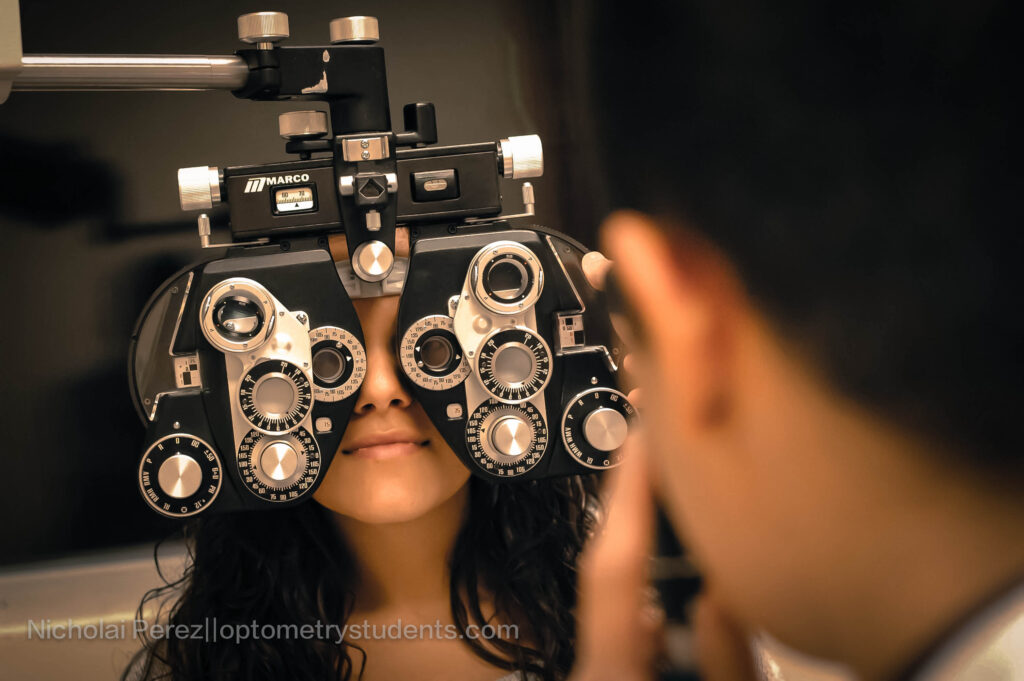Age/Sex/Race
60 year old Caucasian female
Chief Complaint
“Just here for an eye exam. It’s been almost a year. I see fine with current glasses.”
Medical History
Diabetes – last Hg A1c was 6.3
Ocular History
Wears glasses for distance and near
Medications
Insulin, Lisinopril
Allergic to Neomycin
Family History
Retinitis pigmentosa – mother and son
Age-related macular degeneration – father
Diagnosis and initial plan of action
I thought it will be straight forward exam since patient knew about retinitis pigmentosa (RP) and was happy with current glasses.
Applicable Testing & Results of Testing
Entering distance visual acuity through habitual Rx:
OD: -2.50 -0.50 X 073, 20/60; PH: 20/50+
OS: -3.25 sph, 20/30-2; PH: NI
Cover test: Ortho at distance and near
Confrontation fields: constricted visual fields 360 OU
Extraocular muscles: Full OU
Subjective refraction:
OD: -2.75 -0.50 X 105, 20/50
OS: -2.50 – 0.50 X 064, 20/30-2
Add +2.50; 20/30 OU
Pupils: PERRLA, (-) APD OU
Slit lamp examination:
Normal lids
Conunctiva: Normal OU
Cornea: Clear OU
No anterior chamber reaction
IOP: 14 mm Hg OU
Lens: Trace NS OD, clear OS
Dilated Fundus Exam
Patient deferred dilation so posterior pole was observed with 90-D lens only.
OD – Waxy disc pallor, bone specule pigment superior nasal
– Cup-to-disc ratio 0.30/0.30
– Macula (-) FLR
OS – Waxy disc pallor, bone specule pigment superior and inferior nasal
– Cup-to-disc ratio 0.35/0.35
– Macula (+) FLR
OCT: First picture is for right eye and second one is for left eye
Assessment and Plan
OCT revealed partial thickness hole OD. Patient was scheduled to return three days later to see an ophthalmologist and for dilation. However, she did not return for her appointment.
Most common type of a macular hole is idiopathic but it can be complication of posterior vitreous detachment. Other risk factors include myopia, age, trauma, and ocular inflammation. Macular holes can occur in patients with retinitis pigmentosa as well.2 Macular holes are typically seen in females over age of 60. In 30% of cases, macular holes are bilateral. There is a 10% risk of involvement of the other eye at 5 years.1 Most common symptoms of macular hole are blurred vision or central vision loss.3 There are four different stages of macular hole.
Different Stages of Macular Hole
Stage 1a – An impending macular hole, which shows a loss of the foveal depression, loss of the foveal light reflex, and a yellow foveolar spot 100-200 μm. It is rarely seen clinically.
Stage 1b – A foveal detachment with a lipofuscin colored ring. About 50% of stage 1 macular holes resolve spontaneously.1
Stage 2 – A full thickness break <300μm in size with or without a pseudo-operculum, which can occur weeks to months after stage 1. Visual acuity slowly declines at this point.1
Stage 3 – A full thickness break >400 μm in size with an attached posterior vitreous face with or without an operculum. Almost 100% of stage 2 macular hole progress to stage 3.
Stage 4 – A stage 3 macular hole with subretinal fluid and tiny yellowish deposits within it. It is also accompanied with posterior vitreous detachment and Weiss ring.1 Visual acuity is declined drastically at this stage but some patients might have better acuities if they are using eccentric fixation.
In order to detect a macular hole on an eye examination, flourescein angiography and optical coherence tomography (OCT) can be used. OCT is the standard for diagnosis and management of macular hole.2 Surgery is indicated for macular holes stage 2 and above. Surgical treatment, vitrectomy, is most effective for holes that occurred within a year. Vision is improved in 80-90% of eyes post-surgery.
References:
- Kanski, Jack J. Clinical Ophthalmology: A Systemic Approach. Philadelphia 2007: pages 484-485
- http://eyewiki.aao.org/Macular_Hole
- http://cms.revoptom.com/handbook/


